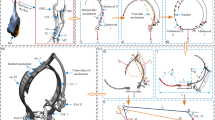Summary
FlyingRhinolophus ferrumequinum lower the frequency of the constant frequency part (f A ) of the emitted sounds in order to compensate for Doppler shifts caused by the flight speed. The echo frequency (f E ) is kept constant within a frequency band of about 200 Hz, the center frequency of which is about 150 Hz above the average or resting frequency (f R ) emitted by roosting bats shortly before take off. For the compensation they use a feedback control system in which the emission frequency is changed to hold the echo frequency at a criterion value. This feedback system was demonstrated by experiments with bats flying in an experimental wind tunnel and in a He-O2-micture. In the wind tunnelRhinolophus lowers the emission frequency in order to compensate for Doppler shifts which are caused by the ground speed flown by the bat. In the He-O2-mixtureRhinolophus compensates for Doppler shifts which correspond to the different sound speeds in the gas mixture.
Similar content being viewed by others
References
Airapetianz, E. Sh., Konstantinov, A. I.: A study of nervous mechanisms of echolocation of bats. Questions of Bionics, Nauka, Moskow, [russisch] 445–453 (1967).
Brosset, A.: The bats of central and western India. Part IV. J. Bombay Nat. Hist. Soc.60, 337–335 (1963).
Brosset, A.: La biologie des Chiroptères. Paris: Masson et Cie. 1966.
Flieger, E., Schnitzler, H.-U.: Ortungsleistungen der FledermausRhinolophus ferrumeguinum bei ein- und beidseitiger Ohrverstopfung. J. comp. Physiol.82, 93–102 (1973).
Griffin, D. R.: Listening in the dark. New Haven: Yale University Press 1958.
Griffin, D. R.: Comparative studies of the orientation sounds of bats. Symp. Zool. Soc. Lond.7, 61–72 (1962).
Griffin, D. R., Dunning, D. C., Cahlander, D. A., Webster, F. A.: Correlated orientation sounds and ear movements of horseshoe bats. Nature (Lond.)196, 1185–1186 (1962).
Grinnell, A. D.: Mechanisms of overcoming interference in echolocating animals. In: Animal sonar systems, vol. I, ed. by R. G. Busnel, p. 451–481. Jouy-en-Josas: Laboratoire de Physiologie acoustique 1967.
Grinnell, A. D.: Comparative auditory neurophysiology of neotropical bats employing different echolocation signals. Z. vergl. Physiol.68, 117–153 (1970).
Grinnell, A. D., Grinnell, V. S.: Neural correlates of vertical localization in echolocating bats. J. Physiol. (Lond.)181, 830–851 (1965).
Konstantinov, A. I., Sokolov, B. V.: Characteristics of ultrasonic orientation signals of horseshoe bats (Rhinolophidae). J. evol. biochem. physiol. [russisch].5, 90–97 (1969).
Neuweiler, G.: Neurophysiologische Untersuchungen zum Echoortungssystem der Großen HufeisennaseRhinolophus ferrwmequinum Schreber 1774. Z. vergl. Physiol.67, 273–306 (1970).
Neuweiler, G., Schuller, G., Schnitzler, H.-U.: On- and off- responses in the inferior colliculus of the greater horseshoe bat to pure tones. Z. vergl. Physiol.74, 57–63 (1971).
Novick, A.: Orientation in palaeotropical bats. I. Microchiroptera. J. exp. Zool.138, 81–154 (1958).
Pye, A.: The structure of the cochlea in Chiroptera. I. Micro-chiroptera: Emballonuridea and Rhinolophoidea. J. Morph.118, 495–510 (1966).
Pye, J. D.: Synthesizing the waveforms of bat's pulses. In: Animal sonar systems, vol. I., ed. by R. G. Busnel, p. 43–65. Jouy-en-Josas: Laboratoire de Physiologie acoustique 1967.
Pye, J. D., Flinn, M., Pye, A.: Correlated orientation sounds and ear movements of horseshoe bats. Nature (Lond.)196, 1186–1188 (1962).
Roeder, K. D.: Echoes of ultrasonic pulses from flying moths., Biol. Bull.124, 200–210 (1963).
Schneider, H., Möhres, F. P.: Die Ohrbewegungen der Hufeisenfledermäuse (Chiroptera, Rhinolophidae) und der Mechanismus des Bildhörens. Z. vergl. Physiol.44, 1–40 (1960).
Schnitzler, H.-U.: Discrimination of thin wires by flying horseshoe bats (Rhinolophidae). In: Animal sonar systems, vol. I. ed by R. G. Busnel, p. 68–87. Jouy-en-Josas: Laboratoire de Physiologie acoustique 1967.
Schnitzler, H.-U.: Die Ultraschall-Ortungslaute der Hufeisen-Fledermüse (Chiroptera-Rhinolophidae) in verschiedenen Orientierungssituationen. Z. vergl. Physiol.57, 376–408 (1968).
Schnitzler, H.-U.: Echoortung bei der FledermausChilonycteris rubiginosa. Z. vergl. Physiol.68, 25–39 (1970).
Schnitzler, H.-U.: Comparison of the echolocation behavior inRhinolophus ferrumequinum andChilonycteris rubiginosa. Bijdr. Dierk.40, 77–80 (1970).
Schnitzler, H.-U.: Fledermäuse im Windkanal. Z. vergl. Physiol.73, 209–221 (1971).
Schnitzler, H.-U.: Die Echoortung der Fledermäuse und ihre hörphysiologischen Grundlagen. Fortschr. Zool., im Druck (1972).
Schnitzler, H.-U., Schuller, G., Neuweiler, G.: Antworten des Colliculus inferior der FledermausRhinolophus euryale auf tonale Reizung. Naturwissenschaften58, 627 (1971).
Schuller, G.: Echoortung beiRhinolophus ferrumequinum mit frequenzmodulierten Lauten. J. comp. Physiol.77, 306–331 (1972).
Webster, F. A.: Some acoustical differences between the bats and men. Proc. of the International Conference on Sensory Devices for the Blind, p. 63–87. London: St. Dunstan's, 1967.
Author information
Authors and Affiliations
Additional information
I would like to thank D. R. Griffin for his generous support and stimulating criticism. I express my appreciation to the New York Zoological Society for the use of its facilities and to R. Brown for technical assistance. The work was supported by grant number GB 7155 from the National Science Foundation to the New York Zoological Society. I also thank J. D. Pye for his suggestions.
Rights and permissions
About this article
Cite this article
Schnitzler, H.U. Control of doppler shift compensation in the greater horseshoe bat,Rhinolophus ferrumequinum . J. Comp. Physiol. 82, 79–92 (1973). https://doi.org/10.1007/BF00714171
Received:
Issue Date:
DOI: https://doi.org/10.1007/BF00714171




